It’s time for our weekly digest of tiny iPhone reviews, courtesy of iPhoneTiny.com, with some extra commentary exclusive to Cult of Mac.
This time, we review Orbital 1.2, Commodore 64, DinoMixer, Green Fingers and Doodle Golf.

It’s time for our weekly digest of tiny iPhone reviews, courtesy of iPhoneTiny.com, with some extra commentary exclusive to Cult of Mac.
This time, we review Orbital 1.2, Commodore 64, DinoMixer, Green Fingers and Doodle Golf.

I’m not going to use the word “iPhone killer” to describe the Nexus One, such phrasing is trite at best. Not to mention that the only thing that’s going to kill the iPhone will be Apple, and then, only when iPhone 4 or whatever comes out.
That said, of the current crop of pretenders the Nexus One seems to be something special. Follow us after the jump for our first impressions after 48 hours.
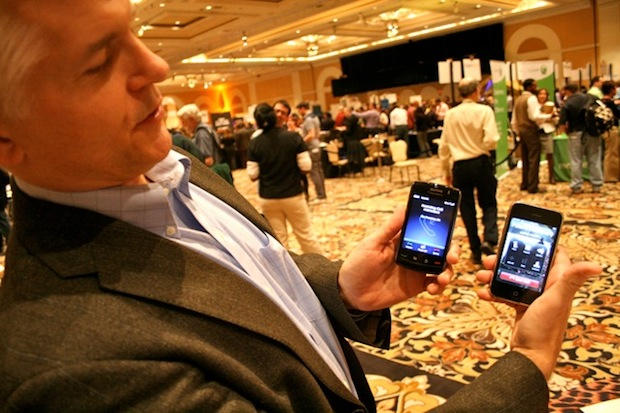
LAS VEGAS — Peter Sisson is the CEO of Toktumi, a San Francisco company with a cool app that adds a second phone number to your iPhone. He kinda looks like Roger Sterling, the silver-haired, hard-drinking, hard smoking character from Mad Men.
Except Peter isn’t smoking, and he isn’t drinking. But he’s certainly got the same moxie. Sisson borrowed someone’s badge to gain entrance to an exclusive, invite-only CES event so that he could pitch a new version of his iPhone app to some of the hundreds of press in attendance. I’m glad he did, because it’s a doozie.

Gadget producers seem to have gotten the message that more bang-for-buck is what sells products in the current economic climate. In keeping with this philosophy, Altec Lansing are showing off three new/refreshed budget-minded offerings at CES.
Left: Altec Lansing says its InMotion Compact is the most compact yet in its line of portable docks. The slim little system was designed with some impressive traits: it’s GSM shielded (so no annoying iPhone buzz), runs on AC or four AA batteries and is faux-leather wrapped. Available for $80, Feb.
Center: The Octane Plus 2.1, a three-piece speaker set with a 6.5-inch subwoofer and 3-inch down-firing mid-range speakers. It’s also much prettier than the VS4121 speaker system it replaces. The set runs $80 and will be available this Spring.
Right: Portable sound from Altec Lansing for a Jackson? Yup. Altec Lansing will offer three versions of their neatly designed, $20 MUZX earbuds, including one with pivoting earpieces. Available March.

LAS VEGAS — Businesses must have a mobile app. That was the message from a CES panel discussion of iPhone apps and their impact on culture, technology, advertising and entertainment.
At the session — iPhone Apps-Change Agents-App Breakthroughs, Video, Games, Mobile Engagement and Advertising — panelists urged companies to get working on mobile apps. Not just for the iPhone, but Android and Palm as well.
“It’s like 10 years ago when the debate was: ‘do I have to get a website or not?’” said Walker Fenton, GM of NewsGator’s Media & Consumer Products. “People were unsure, but these days, the answer is obvious: if you’re not on the Web, it’s like you don’t exist.”
Fenton added that companies must be on the iPhone.
“It’s almost a requirement,” he said. “You’ve got to be on the iPhone; same as you’ve got to be on the Web.”
He concluded: “If you are wondering about whether or not to get on the mobile, the answer is ‘yes’.’ Get on the mobile now.”
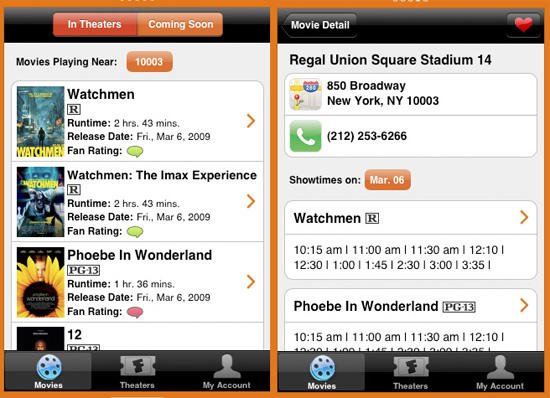
LAS VEGAS — The movie ticketing website Fandango is adding paperless movie ticketing to its iPhone app, an executive said at CES.
Fandango is currently testing an app upgrade that shows Fandango’s ticketing barcode on the screen of the iPhone, instead of having to print it out.
“We’re testing it now,” said Darren Cross of Fandango at a session on iPhone apps. “It’s not too far away. We’ll have it pretty soon.”
An iPhone app that could get you into movie theaters is a big step towards the long-promised ticketless future.
Right now, tickets purchased through Fandango’s site must be printed out at home, and the ticket’s barcode scanned at the theater. It’s pretty painless, but it would be much easier to simply display the barcode on screen.
However, tickets purchased through Fandango’s iPhone app (which is actually easier to use than the website) must be picked up physically at will call. It’s a minor inconvenience, but undermines the electronic nature of the transaction.

Here’s a good idea for virally marketing apps that Apple should think about — wirelessly beaming apps to other iPhones like the Zune’s music sharing feature.
Microsoft’s Zune is mostly a me-too product, but it’s one great feature is being able to lend music to friends Zune-to-Zune via Wi-Fi. Shared tracks can be played three times, after which they must be purchased from the Zune marketplace. It’s a great idea but tragically underused because there are so few Zunes out there.

Thieves looking to get their hands on iPhones have streamlined operations by snatching them while the owner is on the phone, if recent police reports are anything to go by. (If it happens to you, try writing Steve Jobs — he may render justice when police can’t).
Simple but effective: it’s easier than snatching a bag and hoping there’s something good inside, right?
Chicago-based columnist Mark Bazer wrote an open letter to the person who snagged his wife’s month-old iPhone on a train:
Congratulations on your new iPhone! I just know you’re going to love it, as it’s a fantastic device with an easy-to-use interface and photos of my relatives. Heck, they’re now your relatives, too — we’re on the same family plan! That reminds me: It’s your turn this year to host Thanksgiving.
But back to your shiny new iPhone, because there are a number of things you should know to ensure it gives you so much enjoyment that you forget your shame.
For starters, it’s got plenty of room for music, but we weren’t sure what kind you liked. We were hoping Simon and Garfunkel , but if not, just sync that baby up to your PC and create your own mix. (If you don’t have a PC, they can be stolen from most homes.)
Also, we had the foresight to buy you the AppleCare protection plan, so your iPhone is covered for two years if anything goes wrong — with the exception of someone stealing it.
Funny, but it kinda makes me want to grab one, too.
Via Baltimore Sun

LAS VEGAS — Orbitsound claims its T12 Soundbar sounds so good, they refused to demo it on the show floor.
“It just won’t do it justice,” said Ted Fletcher, founder of Orbitsound, which is based in London.
“It’ll revolutionize the way you listen to music,” he added.
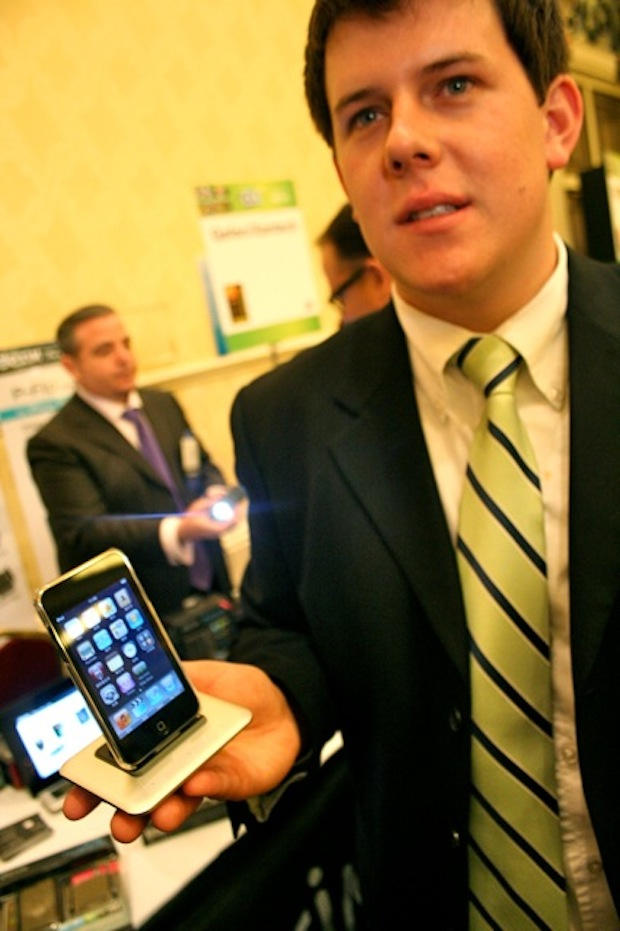
LAS VEGAS — Dexim, a young Chinese company that is starting to win design awards, is at CES showing off an iPod/iPhone docking station.
The MHub Docking Station isn’t the most exciting product here, but looks well-made and well-designed, and promises to reduce a considerable amount of desktop clutter. It includes a iPhone/iPod dock, SD card reader and a three USB connections.
“It really reduces your desktop spaghetti,” said Patrick Tarpey, a spokesman for Dexim.
Priced at $80, the MHub won an International CES Innovations 2010 Design and Engineering Award, and competes with Griffin’s iSimplifi.

LAS VEGAS — Powermat is a wireless charging pad for powering up gadgets without plugging them into their chargers. I’ve been testing a competing product from Pure Energy Solutions for several months, and found that wireless chargers really change your charging habits. My wife and kids, for example, who never charge their cell phones/iPods, have no trouble dropping their gadgets on the Pure Energy’s WildCharger charging pad. For once, there’s not a bunch of lifeless gadgets lying around.
Powermat has noticed similar trends among its buyers, and at CES is showing off several new, inexpensive charging pads priced to encourage users to have several pads around the house.

PocketHeat is an app that has recently been pushed to the iTunes App Store designed to keep your hands warm in the winter. For $0.99, the app will push your iPhone or iPod Touch to its maximum CPU capacity.
It’s rather mystifying that this app got through the App Store approval process, since pushing your iPhone or iPod Touch CPU to the point of meltdown seems risky, to say the least.
Still, it has given me my own killer idea: an exfoliating iPhone app that works by making a user’s handset physically explode. Any developers out there want to help me make it happen?
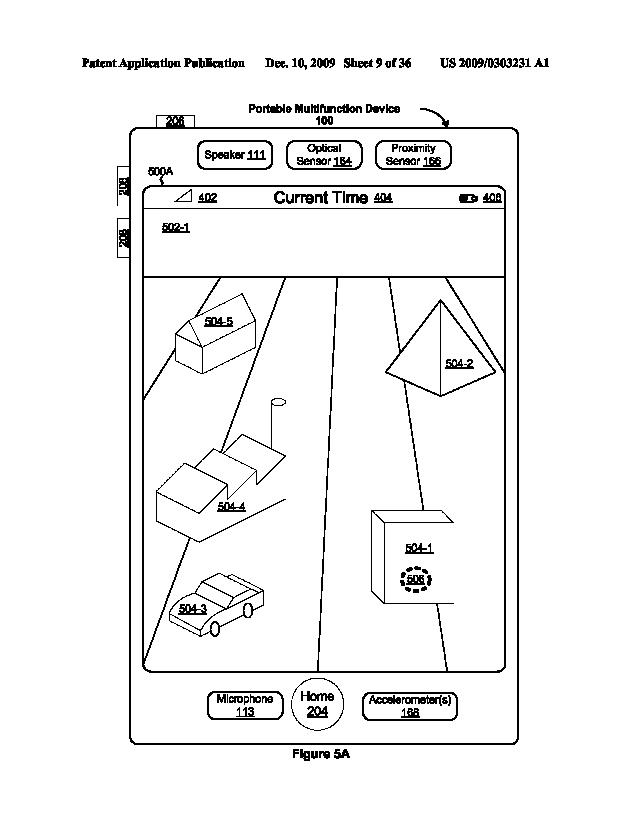
Its publication conveniently timed to coincide with insistent talk about the forthcoming Apple Tablet’s unexpected new interface, Gus Santementes of the Baltimore Sun has spotted a new Apple interface patent that describes a touch-screen device with a graphical user interface for “manipulating three-dimensional virtual objects.”
In essence, the patent — filed by three Apple software engineers — describe a way for users to manipulate 3D virtual objects like an icon, a shape or a character. The patent states that “there is a need for electronic devices with touch screen displays [to] provide more transparent and intuitive user interfaces for navigating in three dimensional virtual spaces and manipulating three dimensional objects in these virtual spaces.”
It’s possible this is the patent office skeleton of the new Tablet UI we’ve been hearing about, but I doubt it. This doesn’t describe much more than a method of interacting with 3D objects on a touchscreen, which isn’t particularly revolutionary.
My guess is that if the new Tablet UI has the dye of the weird to it, it’s going to be a lot less pedestrian than a 3D shell plopped atop the iPhone OS. More interesting is the patent’s description of an internal camera that can be shifted by the user to either back or front mounted positions: that’s something I could easily see coming to the Tablet and future iPhones, if it works up to Apple’s standards.
[via Patently Apple]

LAS VEGAS — The first piece of hardware to take advantage of the iPhone 3.0 OS’s much-heralded hardware interface has finally surfaced at CES. And of all things, it’s a speaker clock from Sharper Image.

LAS VEGAS — Ed Curran is a reporter for WBBM-TV in Chicago, and he’s shooting CES using an iPhone.
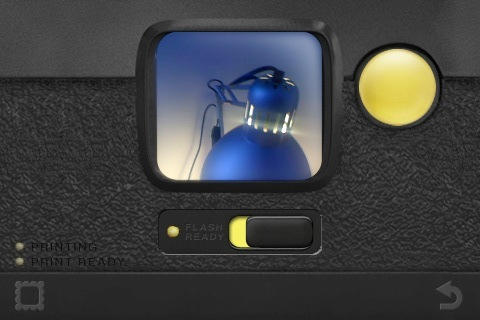
You’ve probably noticed that I tend to get a little overexcited about iPhone photography apps. I got so excited about the Lego Photo app that Pete mentioned the other day, I went and made a Flickr group for it. But this post is about another little gem I’ve found, under the name Hipstamatic.

The giant Consumer Electronics Show in Las Vegas later this week will be all about tablets, eBook readers and 3D TVs. But of primary interest to Apple followers will be the big gathering of iPhone App developers.
More than 100 iPhone developers and accessory makers will exhibit at the iLounge Developer’s Pavilion, up 150% from numbers announced in July.

I’m a bit mystified by the Airstash, the latest iPhone accessory to come out of CES.
It looks good on the tin: the AirStash is a dongle that allows you to greatly expand the internal storage of your iPhone or iPod Touch. You just plug an SD card into it, slap it into your computer, transfer files on over, then put it in your pocket. Now, as long as your iPod Touch or iPhone is in WiFi distance of your AirStash, you can access its contents. But those are all the details we have.
At first blush, those details are enough: who wouldn’t want more space on their iPhone or iPod Touch? But, really, what do we use our internal storage for? Movies, videos and apps. There’s the rub: the AirStash might expand storage, but it won’t allow you to launch apps that are stored on the dongle, and my guess is that it won’t integrate with iTunes for music and movies. That makes this peripheral fairly useless for a large number of people.
My guess is that the AirStash is mostly just a dongle for people who might need to email files that they can’t natively store on their iPhone or iPod Touch. Not bad functionality, certainly, but limited in scope.
Still, this is all speculation: we should know more about the AirStash, including availability and price, later on this week.
[via Engadget]
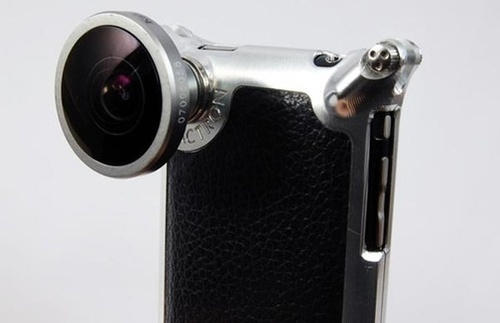
Current internet scuttlebutt has the next iPhone pegged for upgrading its current 3.2-megapixel camera to a 5-megapixel camera, courtesy of Omnivision. That will make the iPhone competitive with other camera phones, at least on the vastly overblown quality criterion of the megapixel scale.
But what if Apple one-upped everyone and slapped a 14.6-megapixel image sensor capable of shooting 1080p video at 60 frames per second into the next iPhone? That’s certainly an option: iPhone camera sensor suppliers Omnivision have just announced the OV14825, which is slated to go into mass production in the second quarter of 2010… just in time for a new iPhone.
Apple might go that route, sure, but let’s all slaughter some pigs on our aluminum unibody altars and pray that they don’t. There isn’t a smartphone on the market with a lens capable of taking advantage of even a 2-megapixel sensor, and there’s no advances to cell phone lenses on the horizon. 14.6 megapixels is sheer lunacy: sure, there’ll be 14.6 million dots, but 12.6 will be random noise.
[via Gizmodo]
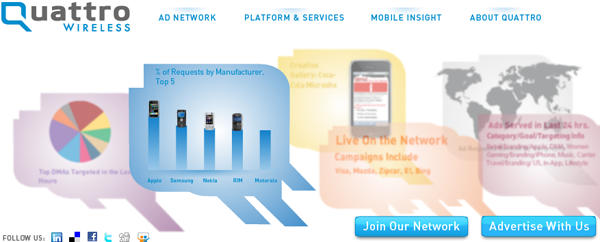
According to Kara Swisher of All Things D, Apple is on the cusp of buying mobile ad company Quattro for $275 million.
No surprise here: Apple was just outbid on mobile ad company Admob by Google for $750 million. Apple is obviously interested in entering the mobile advertising space.
Optimistically, that’s because they recognize that owning the ad network that power all of their App Store apps would make them a killing… although given how poorly the App Store is maintained, one wonders if Apple has the customer service chops to run their own advertising network.
Pessimistically? Apple’s been flirting with some alarming patents for mandatory advertising within OS X. It’s hard to believe they’d go that route, but just the existence of such patents is enough to cause you to arch your eyebrow when Cupertino drops $300 million for an advertising company.
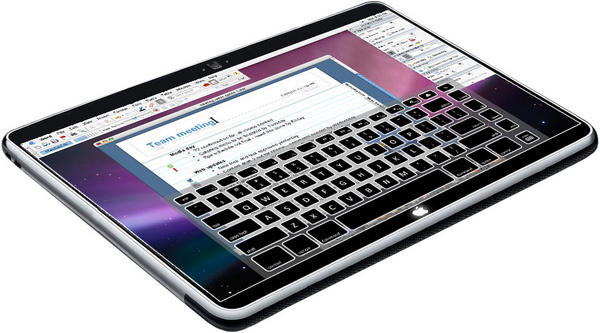
Apple’s January 27th surprise product announcement will see the introduction of the tablet, the iPhone OS 4.0 and an associated Software Development Kit for programmers, the French site Mac4Ever reports.
According to the Mac4Ever (Google translation), the SDK will include a tablet “simulator” to help developers port their iPhone/iPt apps to the tablet’s larger screen.
Several of our sources give us two pieces of information concerning the famous Apple tablet: In late January, in addition to its tablet, Cupertino should have a beta of iPhone OS 4, accompanied by an SDK. Our informants also tell us of a “simulator” specifically adapted for the tablet. Evidently, the major novelty of the SDK therefore concerns the interface, making it easier for developers to adapt to different screen resolutions. The new iPhone could also benefit from a higher pixel density.
Mac4Ever notes that the information should be taken with a grain of salt. But the site recently nailed details of Apple’s new iMac models and Mighty Mouse weeks before they were released.
Mac4Ever also recently claimed that the tablet will be “far different” than most internet mockups, a tantalizing tidbit bolstered by a NYT report that we will be “very surprised how you interact with the new tablet.”

What is it?
Political GPS is, hands down, the best way to leverage your iPhone or iPod Touch as a tool for political activism.
Created by Thomas Huntington, this handy dandy app can help pinpoint your personal location in the political spectrum, provides unprecedentedly comprehensive contact and biographical information for every senator and member of congress in Washington, DC, allows quick access to the full text and summary of every bill passed by the US Congress, back to the 106th — including all versions and amendments — and features the full texts of such seminal documents of freedom as the US Constitution, the Magna Carta and the Declaration of the Rights of Man.
Why it’s Cool:
Did you resolve to become more politically active in the coming year?
Perhaps you’re disenchanted with the return you seem to be getting from your vote in 2008 for Barack Obama or your local senator or congressperson. Perhaps you find yourself firmly in the Libertarian/Conservative quadrant of the political compass and smell both blood and an opportunity to swing the balance of power rightward in November’s midterm elections. Perhaps you’re just intrigued by the idea of a tool that might help you make your voice more easily heard with your representatives in congress.
Political GPS is the app you’ve been waiting for.
No flashy graphics or a fancy GUI here, but a quick 30 question survey helps you place your own political leanings on a compass-like map that measures general attitudes toward ideas of economic and social freedom, plotting your answers on axes measuring liberal/conservative and anarchist/totalitarian tendencies, as well as those for communism/libertarianism and socialism/fascism.
You can view your results in a theoretical landscape or plot them against the views of historical figures such as Abraham Lincoln, Franklin Roosevelt, Joseph Stalin and Ronald Reagan.
Full disclosure: this writer’s views aligned most closely with Ghandi and the Dalai Lama.
Then the real fun begins. Political GPS’s Congress Tracker gives you detailed information for each member of the US Congress. From biographical information and links to each member’s website to in-depth voting information and the ability to easily contact each member by phone, email, or Twitter, Political GPS helps you to learn more about your congress.
The search engine built into political GPS is far more robust and sophisticated than something you might expect to pay $2 for. Search representatives by name or state, search congressional bills by topic, content, title, or bill number; the member tracker and bill tracker databases are linked, too. Comprehensive information about the laws passed by congress and the people passing them has never been so easily accessed.
Full text access to historical documents is the lagniappe in Political GPS. Easily study the US Constitution, the Magna Carta and the Declaration of the Rights of Man right inside the app. Organized by Articles, Sections, and Amendments, it’s easy to go right to the area you want to read and it’s all easy on the eyes with large fonts and antique parchment backgrounds that give the documents a weighty feel without making them harder to read.
For anyone who believes in the idea that you should be the change you want to see in this world, Political GPS is certainly one of the coolest tools available to American iPhone and iPod Touch users.
Where to get it:
Political GPS is available at the Apple iTunes App Store in both free and $1.99 versions. But really, just pony up the $2 and make your voice heard.

Responding to an inquiry made by the FCC to explore the transition to an IP-based communications network, AT&T has asked that a firm date be set for the total extinction of landlines.
“With each passing day, more and more communications services migrate to broadband and IP-based services, leaving the public switched telephone network (‘PSTN’) and plain-old telephone service (‘POTS’) as relics of a by-gone era,” AT&T wrote.
They continued: “It makes no sense to require service providers to operate and maintain two distinct networks when technology and consumer preferences have made one of them increasingly obsolete.”
Given AT&T’s fundamental inability to address the substandard service and network congestion caused by their iPhone exclusivity deal with Apple, it seems blushingly laughable that the telecom would now be asking for the death of landlines, which can only increase network congestion.
But AT&T has a point: for everything but businesses and emergency services, landlines are already a technology of the dodo. AT&T must spend considerable money every year maintaining an increasingly obsolete network, which means funneling away from the development of the clear and rapidly evolving future of telephone communication.

Keeping New Year’s resolutions is hard. Who has the willpower? Here’s 10 iPhone apps that might help.
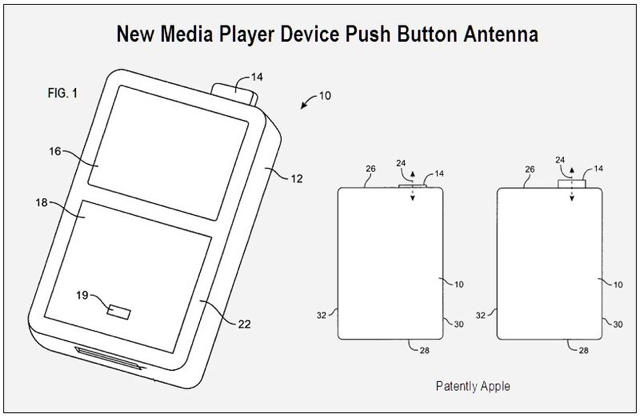
We’ve all learned to live with the iPhone’s woeful reception, but with more and more phones following Apple’s lead and circumcising any and all protuberant nubs from their streamlined smartphones, it’s easy to forget that the iPhone’s reception issues could be fixed with a protruding antenna.
Apple’s own thinking seems to be leaning towards the re-integration of an external antenna into future versions of the iPhone or iPod Touch. According to a patent recently granted to Apple by the US Patent and Trademark Office, Apple may be considering adding a push button style antenna to future devices, in order to ensure “high-quality wireless transmission and reception.”
Don’t worry: we’re not looking at a slide-out set of bunny ears. The antenna design is elegant: the iPhone would retain its streamlined design until the antenna was called for, at which point it would pop out a tiny little antenna nub. If your reception is good enough, you just push it back in.
However, as Patently Apple notes, the most interesting patent detail is that it may utilize a coaxial cable. That implies the ability to pipe in cable television.
Personally, I doubt we’ll see this patent in action any time soon: elegant or not, a pop-out antenna strikes me as too much of a kludge for Apple to take seriously. Still, the prospect of a cable ready iPhone or Apple Tablet is too tantalizing not to report.